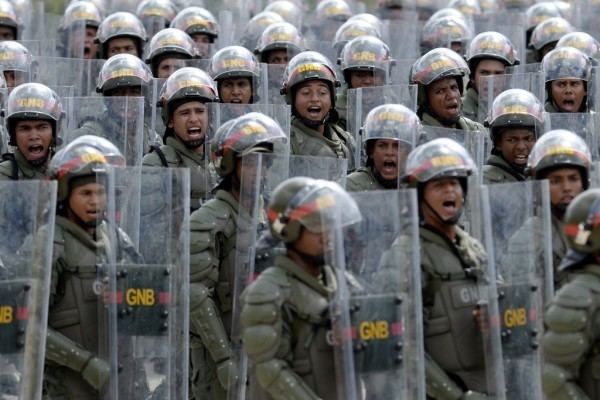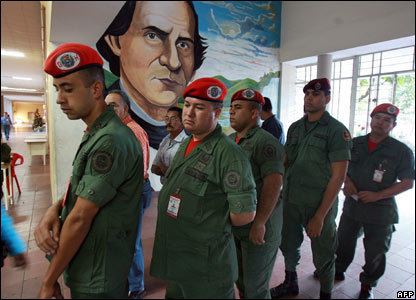Country Venezuela Colors Maroon Founded 4 August 1937, Venezuela | Type Military Police Founder Eleazar López Contreras Color Maroon | |
Role Gendarmerie, forestry protection, civil defense, public order and safety, border control, highway security, coastal security Size 9 Regional Commands and 24 Zone Commands Part of Ministry of Defense, Ministry of Interior and Justice Motto El honor es su divisa (Honor is its emblem) Branch National Bolivarian Armed Forces of Venezuela Patron Our Lady of the Rosary of Chiquinquirá Similar National Bolivarian Armed Fo, Bolivarian Navy of Venezuela, Venezuelan Army, Venezuelan Air Force, Venezuelan National Militia | ||
The Bolivarian National Guard of Venezuela (Spanish: Guardia Nacional de Venezuela), also called the Armed Forces of Cooperation (Spanish: Fuerzas Armadas de Cooperación), is one of the four components of the National Armed Forces of Venezuela. The national guard can serve as gendarmerie, perform civil defense roles, or serve as a reserve light infantry force. The national guard was founded 4 August 1937 by the then President of the Republic, General-in-Chief Eleazar López Contreras. The motto of the NG is "El Honor es su divisa" (Honor is its currency), different from the motto of the Spanish Civil Guard.
Contents
- History
- Organization
- Headquarters National Guard Caracas
- Recruitment
- Uniforms and equipment
- Aircraft
- Helicopters
- Drug Trade
- 201415 Venezuelan protests
- United States sanctions
- References

The National Guard used unlawful force and tortured anti-government demonstrators during the 2014 Venezuelan protests, during which nine guardsmen were killed.
History

The National Guard traces its roots to the gendarmerie and rural police formations organized in 1811 by the National Government and in the subsequent National Police Guard raised in 1841 by President José Antonio Páez, both later disbanded.

In 1934, then Defense Minister General in Chief Eleazar López Contreras, busy with the preparations for his own presidency and in his duty of creating and expanding the national army and navy, realized the long need of public security in a time of civil unrest under President Juan Vicente Gómez, in their meetings during that year. In the middle of the year he had conversations with Venezuelan diplomat Rufino Blanco Fombona, who suggested forming a national gendarmerie modeled on the successes of the Spanish Civil Guard and on the Peruvian Civil Guard, as well as the various other police forces in South America.
Thus the idea of forming the National Guard was born.
On August 31, 1934, Ministry of War and Navy Resolution no. 188 created the Technical Services School, located in Fort Paez, Maracay. The school trained technical service personnel in military technologies and public security. Its Special Classes course arrived the next year.
Upon the death of General Gomez on December 17, 1935, Lopez Contreas became President. The next year, as Commander in Chief of the armed forces, he ordered the raising of a National Frontier Police to protect the national borders and raised mounted security units to protect the peace in the Venezuelan plains. On that same year a Spanish military mission arrived to help form and train a fully national police force, led by Captain Cecillo Suarez of the Civil Guard. The Technical Services School's Special Classes, by that year moved to Caracas, became independent and on September 16, 1935, was disbanded. The next day a Presidential decree ordered the formation of the Public Security Agents Formation School. It opened in Villa Zolia, Caracas on October 28 the same year, with Captain Suarez as its principal guest. His speech implied the basis principles of the future national police force: As "sentinels of the people", a part of the armed forces as a public order and security service, maintaining the law and order, defending social lives and to become the "armed shoulder of the Executive Power" and as an intervening force in times of disorder.
On August 4, 1937, the National Guard was raised via an Presidential Decree of President Eleazar López Contreras, published in the Official Gazette. The presidential decree divided the National Guard into the National Guard of the Interior (subdivided into the Highway, Rural, Health and Urban Services) and the Frontier National Guard, and set its joint command structure under the Ministries of War and Navy and of the Interior and Justice, absorbing into the new service the personnel of the National Frontier Police.. As a national police force it was also mandated to have its own investigations service as well. As a result, the PSAFS became first the National Police Academy and later the National Public Security Academy. On its first graduation on October 12, 1937, Sgt. Martin Torres gave an emotional address to his fellow graduates and to the honorary guests, thanking the Government and the Spanish military mission for forming the new service. The Mission organized the new service until 1941 and thus completed the Charter of the National Guard (based on the Charter of the Civil Guard), with its motto, "Honor is Its Emblem" (based on the Spanish Civil Guard motto). The first National Guard station opened in Tachira on December 6 the same year.
In 1938, Congress passed the National Security Service Law. On November 8, Major Francisco de Paula Angarita Arvelo, Venezuelan Army, was appointed the first Commanding General of the National Guard, thus the NG became an independent arm of the Army. In 1940 the first officer training course was commenced. The service was hit hard by a 1941 reduction, but debuted, with the help of the Federal Bureau of Investigation of the United States, the Military and Police Intelligence Training courses, in 1944. On the same year, via General Orders 16 on April 13 that same year, its joint command structure and duties were amended and the service was formed into a brigade sized formation.
In 1945, the service defended the government of President Isaias Medina Angarita against a coup. In the aftermath, now Lieutenant Torres assumed the leadership of the National Guard becoming the first NG officer to become its commanding general, and the service adopted the green uniforms of the Venezuelan Army, abandoning its earlier blue uniforms. It should be noted that several of the officers of the service had earlier served in the Army before, and in the earlier days the officer corps were made up of Army officers seconded into the service.
In 1946, it became the Armed Forces of Cooperation. The National Guard Academy and the National Guardsmen Formation School were both created that year. The NGA held its first officers graduation in 1947 at its Villa Zolia campus.
A Chilean military mission led by the Carabineros de Chile helped reorganize the National Guard in the same year. Partly as a result it later expanded its responsibilities in the 1950s to include pentinentiary protection and security, maritime security, forestry protection and highway patrol duties as well as security in the tourism sector and even in dog handling. Its present formation of 12 regional commands dates from 1950 when the 1st Regional Command was raised. In the late 1970s the Guard established its own air arm.
It returned to its original name in the onset of the 21st century and by 2014 the State National Guard Commands were established.
Organization
The National Guard is structured as follows.
Headquarters, National Guard - Caracas
Controls eight or more Mobile Detachments of battalion or regiment size available for deployment to any area of the country in response to threats to internal security or border security.
The command has under its control all nine "regional commands" which control local battalion or regiment-sized National Guard detachments which provide static defense of certain public buildings, oil installations, and penal institutions (the latter duties now shared with the Policia Nacional Bolivariana) and for the maintenance of public security. Additionally, they patrol the nation's highway system, functioning as a federal highway police force. They also serve as the nation's coast guard and maritime search and rescue service, co-sharing with the Bolivarian Navy of Venezuela's Coast Guard Command in this duty in the coastal states. These are now subdivided into state level zone commands serving all the states of Venezuela. Most of the RCs and SZCs also control the 16 local rural service commando battalions for keeping order in rural communities, but only the Caracas Capital District ZS has none, instead having 7 area detachments as of present with 3 regiment sized.
Created by Hugo Chávez in 2011 for Guardsmen mandated for police protection alongside the Bolivarian National Police and aimed at keeping peace and order as well as fighting against drug-related and alcohol-related crimes and the illegal arms and drug trade in the country. They also help in public works repairs and ensuring security during major holidays. The service today is composed of 17 state level People's Guards Regiments in several of the States of Venezuela and the Venezuelan Capital District, with more to be raised soon, together with 29 independent People's Guards Battalions and 21 Public Safety Battalions in major cities nationwide. The regiments are each divided into 2 to 4 battalion-sized detachments and a headquarters unit.
This command is in charge of combating the use and spread of illegal drugs in Venezuela and works with other South American police forces in fighting the illegal drug trade in the continent.
Mandated for the protection of Venezuela's natural resources, especially the ancestral lands of its indigenous peoples, and the enforcement of environmental laws.
The newest command of the National Guard mandated to counter financial crimes and serious criminal activities formed up of the National Guard Anti-Extortion and Sequestration Groups (GAES - Grupo Anti-Extorsión y Secuestro) in every Venezuelan state, created via Ministerial Resolution of the Ministry of Defense No. 000568 on April 4, 2013. All the states plus the Capital District have one AESG detachment each to fight serious crimes. The command is led by BGEN Alexis Escalona Marrero.
Recruitment
The VNG is an all volunteer force with over 38,000 men and women. Recruits undergo a two-year basic training course at the Ramo Verde National Guard Formation School at Los Teques, as well as at various formation schools nationwide. Officer candidates are required to study for an additional four years at the Officers Training Academy of the National Guard in Caracas and at the Military Technical Academy in Maracay for the technical service officers. Postgraduate studies for officers are available at the Advanced Officers School at Caricuao, near Caracas.
Uniforms and equipment
The VNG have the same rank insignia and uniforms as the Venezuelan Army. However the VNG normally wear a maroon beret instead of the Army's black berets.
The VNG is equipped as a light infantry force, with the standard FN FAL assault rifle (being replaced with the AK-103), light machine-guns, and mortars up to 81mm.
It possesses over forty Unimog UR-416 wheeled armored personnel carriers and Walther G22 on airports. It acquired 141 Chinese Norinco VN-4 4x4 wheeled armored vehicles in 2012, and 50 in 2013. In 2014, during the 2014 Venezuelan protests, the Venezuelan government order 300 more VN-4 vehicles. In July 2013, it ordered Chinese Type 63A light tanks. Austrian and Japanese vehicles are also used.
The VNG also employ eighty small craft for coastal and river patrol duties as part of its Naval Coastal Vigilance Command.
The Air National Guard Command operates over 50 fixed-wing light aircraft and helicopters.
Aircraft
Helicopters
Drug Trade
In 1993, the term Cartel de los Soles or Cartel of the Suns was first used when allegations of two National Guard generals, who wore emblems that looked like suns on their uniforms, were investigated for drug trafficking crimes. The term currently describes high-ranking members of the Venezuelan armed forces, including the National Guard, who are involved in drug trade. Even lower ranking National Guardsmen compete for positions at border checkpoints so they can be paid bribes for "illicit trade", though a large portion of bribes go to their superiors. The corrupt officials of The Sun Cartel traffic drugs from Colombia to Venezuela where they are shipped internationally. It has been alleged that the National Guard had worked with the FARC with drug trade.
In September 2013, an incident allegedly linked to The Sun Cartel and involving men from the Venezuelan National Guard who placed 31 suitcases containing 1.3 tons of cocaine on a Paris flight astonished French authorities as it was the largest seizure of cocaine recorded in mainland France. On 15 February 2014, a commander for the Venezuelan National Guard was stopped while driving to Valencia with his family and was arrested for having 554 kilos of cocaine in his possession.
2014–15 Venezuelan protests
The National Guard has used tear gas and rubber bullets on anti-government demonstrators during the 2014–15 Venezuelan protests, during which 9 members of the National Guard have been killed. There are reports alleging that the Venezuelan National Guard has worked with groups labelled 'colectivos' while dispersing protesters. The National Guard allegedly protected the Tupamaro colectivo that were "armed with guns, motorcycles and shooting protesters". The National Guard also protected the Tupamaro colectivo that were "armed with guns, motorcycles and shooting protesters".
Human Rights Watch reports that "many victims and family members we spoke with said they believed they might face reprisals if they reported abused by police, guardsmen, or armed pro-government gangs." It also reported that a man attempting to leave a protest was shot with rubber bullets, beaten and then shot again in the groin by guardsmen. Another man was detained, shot repeatedly with rubber bullets, beat with rifles and helmets by three National Guardsman and was asked "Who's your president?" NTN24 reported from a lawyer that National Guardsmen and individuals with "Cuban accents" in Mérida forced three arrested adolescents to confess to crimes they did not commit and then the adolescents "kneeled and were forced to raise their arms then shot with buckshot throughout their body" during an alleged "target practice". In Valencia, protesters were dispersed by the National Guard in El Trigál where four students (three men and one woman) were attacked inside of a car while trying to leave the perimeter; the three men were imprisoned and one of them was allegedly sodomized by one of the officers with a rifle.
United States sanctions
Following alleged human rights violations by the Venezuelan National Guard during the protests, President Barack Obama used powers granted from the Venezuela Defense of Human Rights and Civil Society Act of 2014 and ordered the United States Department of the Treasury to freeze assets and property of former leader of the National Guard, Antonio José Benavides Torres, and former General Commander Justo José Noguera Pietri.
